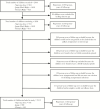Transmission and Age Impact the Risk of Developing Febrile Malaria in Children with Asymptomatic Plasmodium falciparum Parasitemia
- PMID: 30307567
- PMCID: PMC6386809
- DOI: 10.1093/infdis/jiy591
Transmission and Age Impact the Risk of Developing Febrile Malaria in Children with Asymptomatic Plasmodium falciparum Parasitemia
Abstract
Background: Plasmodium falciparum infections lead to febrile illness unless the host has sufficient immunity, in which case infection may cause no immediate symptoms (ie, "asymptomatic parasitemia"). Previous studies are conflicting on the role of asymptomatic parasitemia in determining the risk of developing febrile malaria.
Methods: We monitored 2513 children (living in Kilifi, Kenyan Coast) by blood smears in 17 cross-sectional surveys to identify asymptomatic parasitemia and used active surveillance over 11325 child-years of follow-up to detect febrile malaria. We evaluated the interaction between transmission intensity, age, and asymptomatic parasitemia in determining the risk of developing febrile malaria.
Results: In the moderate and high transmission intensity settings, asymptomatic parasitemia was associated with a reduced risk of febrile malaria in older children (> 3 years), while in the lower transmission setting, asymptomatic parasitemia was associated with an increased risk of febrile malaria in children of all ages. Additionally, the risk associated with asymptomatic parasitemia was limited to the first 90 days of follow-up.
Conclusions: Asymptomatic parasitemia is modified by transmission intensity and age, altering the risk of developing febrile episodes and suggesting that host immunity plays a prominent role in mediating this process.
Keywords: Plasmodium falciparum; age; asymptomatic; immunity; transmission.
© The Author(s) 2018. Published by Oxford University Press for the Infectious Diseases Society of America.
Figures



Similar articles
-
Clearance of asymptomatic P. falciparum Infections Interacts with the number of clones to predict the risk of subsequent malaria in Kenyan children.PLoS One. 2011 Feb 24;6(2):e16940. doi: 10.1371/journal.pone.0016940. PLoS One. 2011. PMID: 21383984 Free PMC article.
-
Microscopic and Submicroscopic Asymptomatic Plasmodium falciparum Infections in Ghanaian Children and Protection against Febrile Malaria.Infect Immun. 2020 Sep 18;88(10):e00125-20. doi: 10.1128/IAI.00125-20. Print 2020 Sep 18. Infect Immun. 2020. PMID: 32719157 Free PMC article.
-
Maintenance of high temporal Plasmodium falciparum genetic diversity and complexity of infection in asymptomatic and symptomatic infections in Kilifi, Kenya from 2007 to 2018.Malar J. 2022 Jun 20;21(1):192. doi: 10.1186/s12936-022-04213-7. Malar J. 2022. PMID: 35725456 Free PMC article.
-
Multiplicity of Asymptomatic Plasmodium falciparum Infections and Risk of Clinical Malaria: A Systematic Review and Pooled Analysis of Individual Participant Data.J Infect Dis. 2020 Feb 18;221(5):775-785. doi: 10.1093/infdis/jiz510. J Infect Dis. 2020. PMID: 31585009 Free PMC article.
-
The silent threat: asymptomatic parasitemia and malaria transmission.Expert Rev Anti Infect Ther. 2013 Jun;11(6):623-39. doi: 10.1586/eri.13.45. Expert Rev Anti Infect Ther. 2013. PMID: 23750733 Review.
Cited by
-
Asymptomatic Plasmodium falciparum carriage at the end of the dry season is associated with subsequent infection and clinical malaria in Eastern Gambia.Malar J. 2024 Jan 17;23(1):22. doi: 10.1186/s12936-024-04836-y. Malar J. 2024. PMID: 38229097 Free PMC article.
-
Impact of asymptomatic Plasmodium falciparum infection on the risk of subsequent symptomatic malaria in a longitudinal cohort in Kenya.Elife. 2021 Jul 23;10:e68812. doi: 10.7554/eLife.68812. Elife. 2021. PMID: 34296998 Free PMC article.
-
Distinct transcriptomic signatures define febrile malaria depending on initial infective states, asymptomatic or uninfected.BMC Infect Dis. 2024 Jan 29;24(1):140. doi: 10.1186/s12879-024-08973-2. BMC Infect Dis. 2024. PMID: 38287287 Free PMC article.
-
Amplicon Sequencing as a Potential Surveillance Tool for Complexity of Infection and Drug Resistance Markers in Plasmodium falciparum Asymptomatic Infections.J Infect Dis. 2022 Sep 13;226(5):920-927. doi: 10.1093/infdis/jiac144. J Infect Dis. 2022. PMID: 35429395 Free PMC article.
-
Evidence for exposure dependent carriage of malaria parasites across the dry season: modelling analysis of longitudinal data.Malar J. 2023 Feb 3;22(1):42. doi: 10.1186/s12936-023-04461-1. Malar J. 2023. PMID: 36737743 Free PMC article.
References
-
- World Health Organization. World Malaria Report Geneva: World Health Organization,2017.
-
- de Mast Q, Brouwers J, Syafruddin D, et al. . Is asymptomatic malaria really asymptomatic? Hematological, vascular and inflammatory effects of asymptomatic malaria parasitemia. J Infect 2015; 71:587–96. - PubMed
-
- Cottrell G, Moussiliou A, Luty AJ, et al. . Submicroscopic Plasmodium falciparum infections are associated with maternal anemia, premature births, and low birth weight. Clin Infect Dis 2015; 60:1481–8. - PubMed

